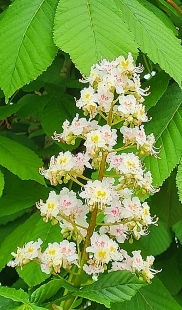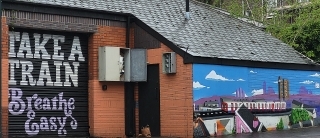Adam Yamey's Blog: YAMEY, page 16
May 4, 2025
It is that time of year again at the Isabella Plantation in Richmond Park
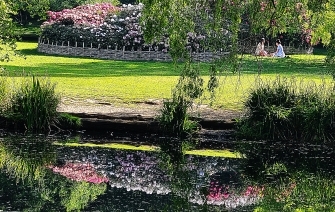
WORDS ARE INADEQUATE to describe the magnificent display of colours that can be seen in the Isabella Plantation at Richmond Park at the end of April and the start of May. I have written about this lovely garden many times before (e.g. https://adam-yamey-writes.com/2021/05/21/a-floral-fireworks-display/) and outlined its history, Do not take it from me that this display of flowering plants (including azaleas, rhododendrons, camelias, bluebells, and much more) is unbelievably beautiful, but hurry there and see it for yourself!
May 3, 2025
A beach in the heart of London
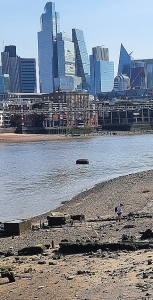
The River Thames is tidal where it flows through the heart of London. At low tide, sandy beaches appear alongside the river’s banks. What is often beneath the water is revealed for a few hours. People, known as ‘mudlarks. wander along the sandy beaches looking for objects and fragments that have been thrown into, or lost in, the water over the many centuries that the city has been in existence. I have never attempted mudlarking, but many people enjoy searching for lost treasures.
May 2, 2025
From goatherd to ceramicist via a Wimpy bar in Hertfordshire
HITCHIN IN HERTFORDSHIRE is the home of the North Hertfordshire Museum. Until 25 May 2025, it is holding an exhibition of the ceramic artworks of Abdo Nagi (1941-2001). He began life in Yemen, where during his early years he was a goatherd. When he was 12 years old, against his father’s wishes, he moved to Aden, where he worked for British ‘ex-pat’ families living there. In 1967, he moved to the UK with his then employer, and eventually settled in Letchworth (Hertfordshire). To earn a living, he worked in a Wimpy bar, then a hotel, and then an engineering firm.
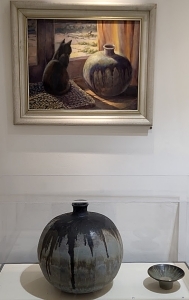
After passing O’level and then A’ level examinations in art, Nagi was appointed Assistant art Technician at North Hertfordshire College. It was here that his creativity began to flower. He began creating ceramic artworks that were inspired by his Yemeni background, and made money by selling them. Then he took a degree in ceramics at Middlesex, graduating in 1988. From then on, his artistic career took off. His work was exhibited in important shows all over the country. The North Hertfordshire Museum bought three of them for their collection. Sadly, a heart attack killed him at the age of 60.
The works currently on show in Hitchin’s fine museum are well-displayed alongside pictures of Abdo at work and various portraits of him painted by local artists. I liked almost all of the works on display. Some of them are unusually shaped, possibly inspired by the crafts of his native land. There is nothing in the exhibition that I would not like to possess – and some of the works are on sale. If you happen to be passing anywhere near Hitchin (a lovely historic town), making a detour to see this show would be worthwhile.
May 1, 2025
Pinch punch, first of the month
April 30, 2025
A cafe in a church in London designed by Christopher Wren
ST NICHOLAS COLE Abbey is a church a few yards southeast of London’s St Paul’s Cathedral. Like the cathedral, St Nick’s (as it is affectionately known) was designed by Sir Christopher Wren and built between 1672 and 1678. The earlier church on this site had been destroyed during the Great Fire of London in 1666. It was the first of the 51 churches lost in the Fire to have been rebuilt. In 1941, it was severely damaged during a German air raid. It remained a shell until it was repaired and reconsecrated in 1962. Sadly, the windows designed by the pre-Raphaelite artist Edward Burne-Jones were destroyed in the air raid. They have been replaced by three attractive windows, which reminded me of the work of Chagall, designed by Keith New (1925-2012).
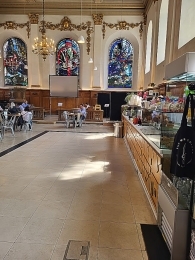
When we entered the church today (28 April 2025), we found that the floor of its spacious interior was occupied by tables and chairs and along its south side, there was a counter where hot and cold drinks as well as snacks were being served. Most of the tables and chairs were occupied. Some people were enjoying refreshments, others were working with their laptop computers, and yet others were chatting quietly. There are also tables and chairs on the terrace outside the south side of the church. Although the church serves as a café on weekdays, during weekends and on some other days, services are held.
The café has been in existence for about 10 years. Although we have passed the church innumerable times, it was only today that we first ventured inside it. So near to St Pauls and all the eateries catering to tourists visiting it, this church-cum-café seems to be well off the tourists’ beaten track, but well-known to local office workers.
April 29, 2025
A church with injuries in a village in Cambridgeshire
WE OFTEN VISIT the excellent Pig and Abbot pub in the tiny village of Abington Piggots in south Cambridgeshire because it has good food and a homely atmosphere. Near the pub stands the parish church of St Michael and All Angels, parts of whose structure date to the twelfth century. It contains many interesting features including a seventeenth century pulpit combined with a reading desk and a clerk’s desk. This is made from timber panelling including some carvings and is probably Flemish in origin. Fascinating as this is, there are two unusual features, which were pointed out to us by a church volunteer when we visited the church in April 2025.
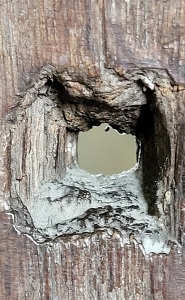
The north door of the nave, which faces the entrance on the south side of the church, has two small squarish holes in it. And if you look carefully at the stone archway that marks the boundary between the nave and the chancel, you can see that a small chunk of masonry is missing. The holes in the door were most likely caused by the sharp tip of a spear or of a pikestaff. The missing chunk of masonry is most likely the result of musket shot having been fired at the archway. It is believed that the damage to the door and the archway was done in the time of Oliver Cromwell, when he had ordered the removal of decorative features from churches, Interestingly, a few panes of mediaeval stained glass remain intact high up in a window in the north wall of the nave. Clearly, Cromwell’s men missed these while they were destroying the rest of the stained glass.
The damage to the church reminded me of our recent trip to Beverley in Yorkshire when we were shown damaged caused by a bullet fired from a Luftwaffe aeroplane during WW2. (see https://adam-yamey-writes.com/2025/04/06/pierced-by-a-bullet-while-praying-in-the-pews/). Clearly nothing is sacred, not even in a church.
April 28, 2025
Graffiti of historic interest in a church in Cambridgeshire
LITLINGTON IS A SMALL village in the south of Cambridgeshire. Its parish church, St Catherine’s, dates from about 1150. Between then and the 15th century, it underwent many modifications. As in many old buildings, people have inscribed graffiti into the church’s stone walls. One stone in one of the south windows has some especially interesting graffiti.
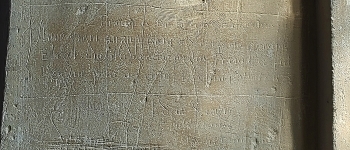
The neatly carved inscription (in Latin), which refers to the great sailor Sir Francis Drake (c1540 – 1596) reads:
“Francis Drake, knight, about to set sail in the thirty-seventh year of the reign of the most august and serene princess Elizabeth, by the grace of God Queen of England, France and Ireland, defender of the faith. 1595. Always the same. The same always. John Sherman, April the tenth.”
The date refers to the year of Drake’s final voyage, from which he never returned (he was ‘buried’ at sea near Portobelo (now in Panama)). Drake had set out from Plymouth in September 1595 to carry out activities against the Spanish in Puerto Rico and other places in and around the Caribbean.
John Sherman lived in Litlington, as did his son-in-law, Robert Bownest, who died during Drake’s final voyage. In “A History of the County of Cambridge and the Isle of Ely: Volume 8” (published in 1982), we can read:
“John Sherman died in 1599, having transferred his manor and other purchased lands in 1597 to his eldest son William”
John’s father, William, was a wealthy landowner in Litlington. What is not clear is whether this John Sherman wrote the inscription and if he participated in in Drake’s ill-fated expedition of 1595, as did his son-in-law.
Tiny details such as the inscription I have described help to make visits to places in England really interesting, and, in a way, help to give vitality to what are otherwise simply historical events.
April 27, 2025
When two holy men meet in a picture from Afghanistan
VISITING CHRISTIE’S AUCTION house near London’s Piccadilly is never disappointing. There are usually items on display, waiting to be auctioned, which are of great interest. Today (25 April 2025), we viewed the items awaiting a sale that will be held on the first of May. The sale is called “Art of the Islamic and Indian Worlds Including Rugs and Carpets”. Standing alone in one room is a folio (page) with coloured paintings on its front and back. This item has been called “The Prophet Muhammad Meets Jesus in the Beit Al-Ma’mur and the Arrival at the The Fourth Heaven”. It was created in Afghanistan in about 1466, and is in remarkably good condition.
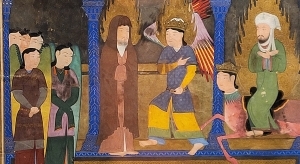
The images show two episodes in the Mi’raj, which as the Christie’s website explained is:
“… one of the most important moments in the life of the Prophet Mohammed. In the Qur’an, sura al-‘Isra alludes to the fact that Allah transported ‘his servant Muhammad by night from the Masjid al-Haram to the Masjid al-Aqsa, whose surroundings we have blessed, so that We may show him some of Our signs’. Though traditions vary, most take this to be a reference to the Prophet being miraculously taken from Mecca to Jerusalem and thence to Heaven.”
Muhammad is depicted as riding on Buraq, his quadruped mount. In the picture at Christie’s, Buraq has been shown as having a human head. In one picture, the Prophet Muhammad is dressed in green and can be seen riding on Buraq and meeting a man dressed in brown robes, who is Jesus (Isa) Christ. In between Jesus and the Prophet, there is a figure with wings, the angel Jibra’il (Gabriel). These holy men are shown meeting in the Beit Al-Ma’mur, which is a celestial form of the Holy Kaaba at Mecca. The picture on the reverse of the folio, we find the Angel Gabriel depicted again. He seems to be heading for a group of angels, followed by the Prophet dressed in green and riding on Buraq. The angels in the picture are shown greeting the Prophet and Gabriel as they make their way through the tiers of heaven.
Apart from being amazingly beautiful, there were some details that caught my eye. Jesus is depicted with a face that could be Arabic. All the other faces, including that of Muhammad, have oriental eyes typical of Central Asia or further east. The faces of others in the pictures, including that of Buraq, are typically Far Eastern in type. I suppose that in 15th century Afghanistan, Central Asian faces were a familiar sight. In the picture that depicts Muhammad moving towards the angels, much of the space surrounding the figures is filled with swirling golden clouds which makes the picture look like a Chinese creation at first sight. Another detail that interested me, and which I spotted in some other pictures on display at Christies, was that although the artist had drawn a frame around the image, one angel seemed to be standing partly outside the frame.
One of the delightful features about Christie’s is that if one asks a member of staff a question about an exhibit, he or she will go out of their way to answer it accurately. In the case of the pictures described above, a gallery assistant asked one of the specialists who dealt with it to come from her office to discuss it with us. This lady answered our questions and explained that what we were looking at is extremely rare. The folio at Christie’s was from a book, whose pages have been dispersed to many different places over time. In Paris there is another very similar but slightly older example of that book, but the page with the episodes I have just described has been lost from it.
The auction whose lots we saw on display contains many fine Mughal and other Indian pictures and objects, as well as items, such as the folio, which originated in Islamic countries such as Persia, Turkey, and places in Central Asia. Once again, a visit to Christie’s has proved most rewarding.
April 26, 2025
Covering the walls with flowers
AT THIS TIME OF the year (April), many walls in London are partly hidden behind the exuberant bunches of flowers sprouting from the twisted trunks of Wisteria plants.
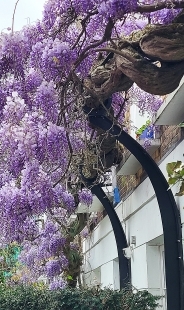
The Wisteria was originally grown in China, Japan, Korea, Vietnam, southern Canada, the north of Iran, and in the east of the USA. The first Wisteria plant to be grown in Britain was imported from Canton in China in 1816, This was a Wisteria sinensis plant. In 1830, another variety was introduced from Japan. Both varieties have both mauve flowers and white flowers.
In and around London’s Kensington, where I live, although both colours of flower can be seen, the mauve outnumbers the white.

